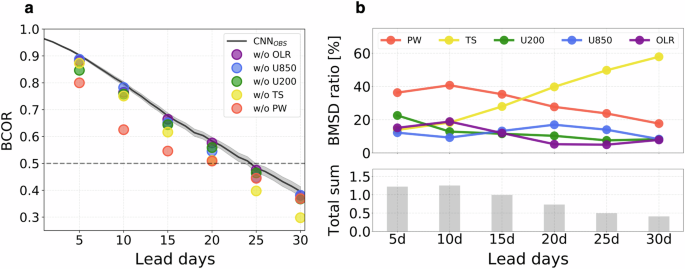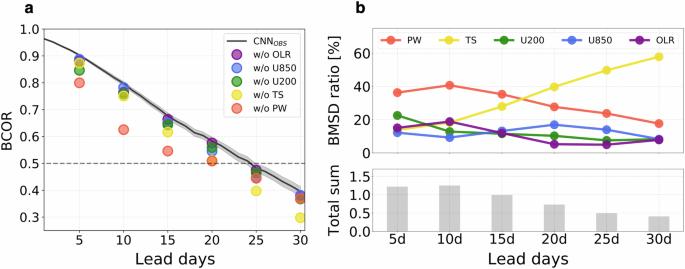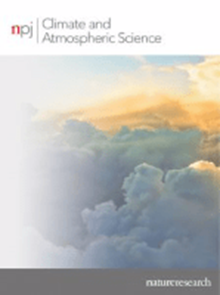关于北方夏季 MJO 可预测性的数据驱动调查
IF 8.5
1区 地球科学
Q1 METEOROLOGY & ATMOSPHERIC SCIENCES
引用次数: 0
摘要
夏季 MJO 具有不同于冬季 MJO 的特征,尤其是在向东和向北两个方向上的传播,而人们对这一特征的了解相对较少。在此,我们利用基于长期气候模式模拟的机器学习(ML)及其与观测数据的迁移学习,探索夏季 MJO 可预测性的主要来源。我们基于 ML 的夏季 MJO 预测模型在约 24 天的预报提前期显示出 0.5 的相关技能。通过利用可解释人工智能(XAI),我们发现可降水量(PW)和表面温度(TS)是对夏季 MJO 可预测性最有影响的来源。通过基于 XAI 的敏感性实验,我们特别确定了东印度洋和北印度洋地区的可降水量和表面温度对夏季 MJO 传播特征的作用。这些结果表明,基于 ML 的方法有助于识别可预测性的来源及其在气候现象中的作用。本文章由计算机程序翻译,如有差异,请以英文原文为准。


Data-driven investigation on the boreal summer MJO predictability
The summer MJO exhibits different characteristics from its winter counterpart, particularly distinguished by propagation in both eastward and northward directions, which is relatively less understood. Here, we explore the primary sources of the summer MJO predictability using Machine Learning (ML) based on the long-term climate model simulation and its transfer learning with the observational data. Our ML-based summer MJO prediction model shows a correlation skill of 0.5 at about 24-day forecast lead time. By utilizing eXplainable Artificial Intelligence (XAI), we discern Precipitable Water (PW) and Surface Temperature (TS) as the most influential sources for the summer MJO predictability. We especially identify the roles of PW and TS in the eastern and northern Indian Ocean (EIO and NIO) regions on the propagation characteristics of the summer MJO through XAI-based sensitivity experiments. These results suggest that ML-based approaches are useful for identifying sources of predictability and their roles in climate phenomena.
求助全文
通过发布文献求助,成功后即可免费获取论文全文。
去求助
来源期刊

npj Climate and Atmospheric Science
Earth and Planetary Sciences-Atmospheric Science
CiteScore
8.80
自引率
3.30%
发文量
87
审稿时长
21 weeks
期刊介绍:
npj Climate and Atmospheric Science is an open-access journal encompassing the relevant physical, chemical, and biological aspects of atmospheric and climate science. The journal places particular emphasis on regional studies that unveil new insights into specific localities, including examinations of local atmospheric composition, such as aerosols.
The range of topics covered by the journal includes climate dynamics, climate variability, weather and climate prediction, climate change, ocean dynamics, weather extremes, air pollution, atmospheric chemistry (including aerosols), the hydrological cycle, and atmosphere–ocean and atmosphere–land interactions. The journal welcomes studies employing a diverse array of methods, including numerical and statistical modeling, the development and application of in situ observational techniques, remote sensing, and the development or evaluation of new reanalyses.
 求助内容:
求助内容: 应助结果提醒方式:
应助结果提醒方式:


